| |
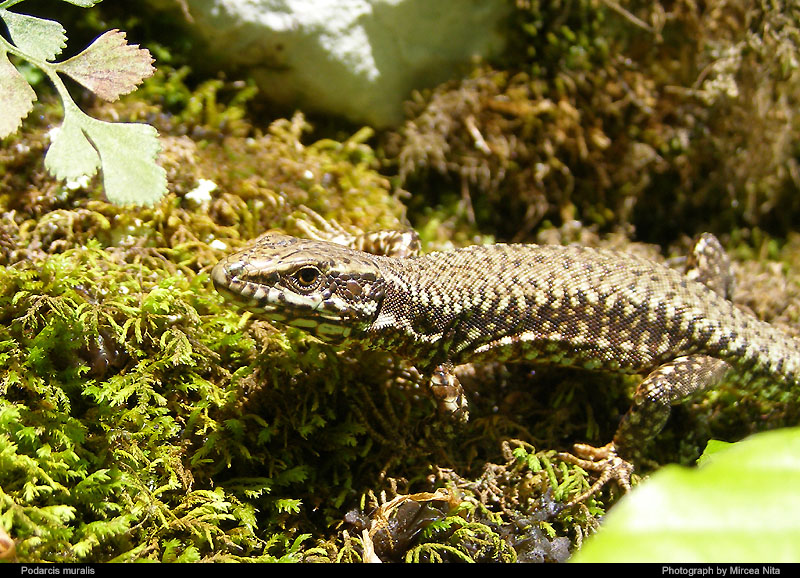
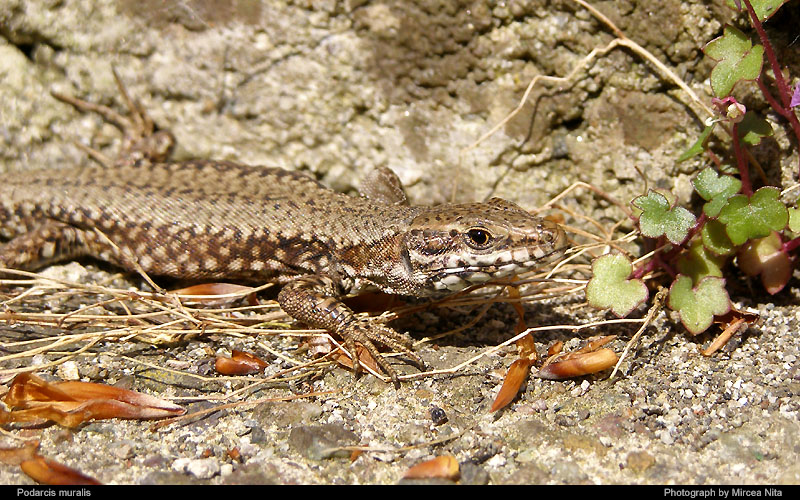
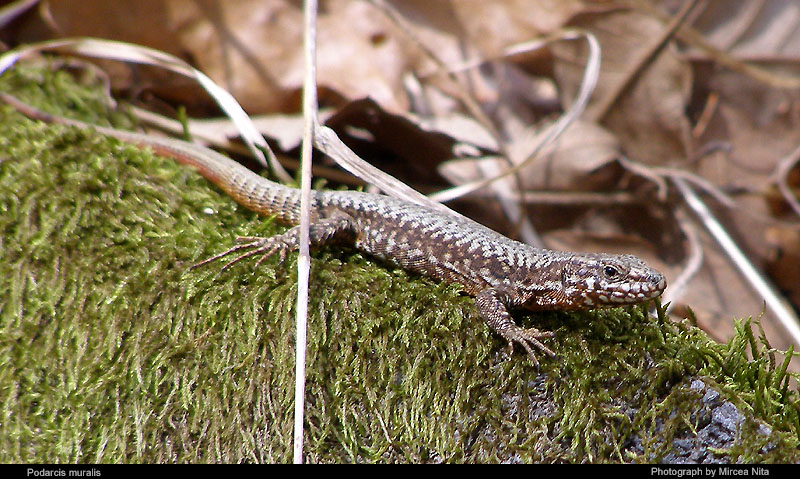
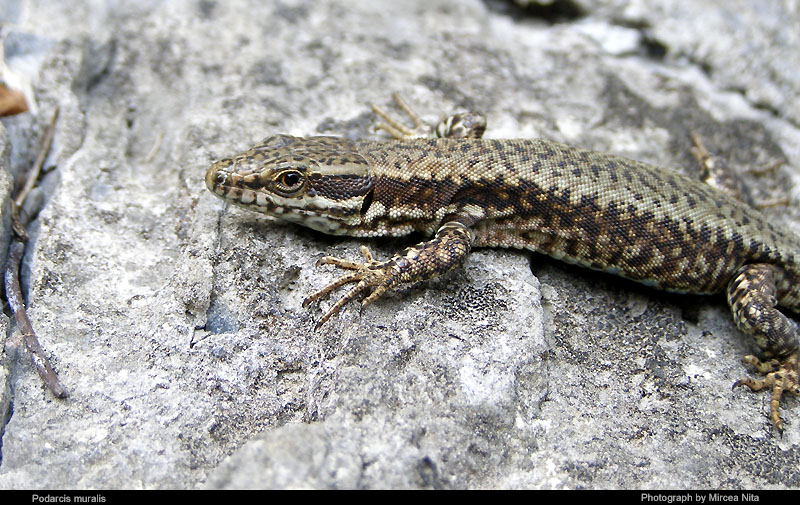
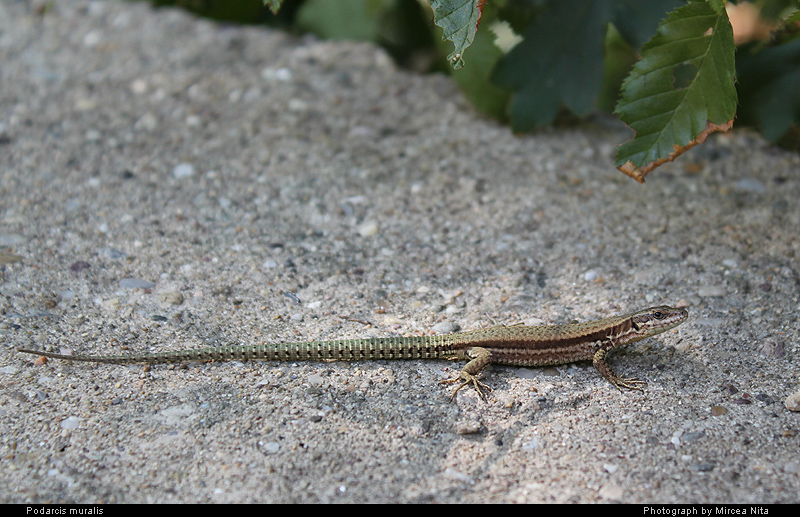
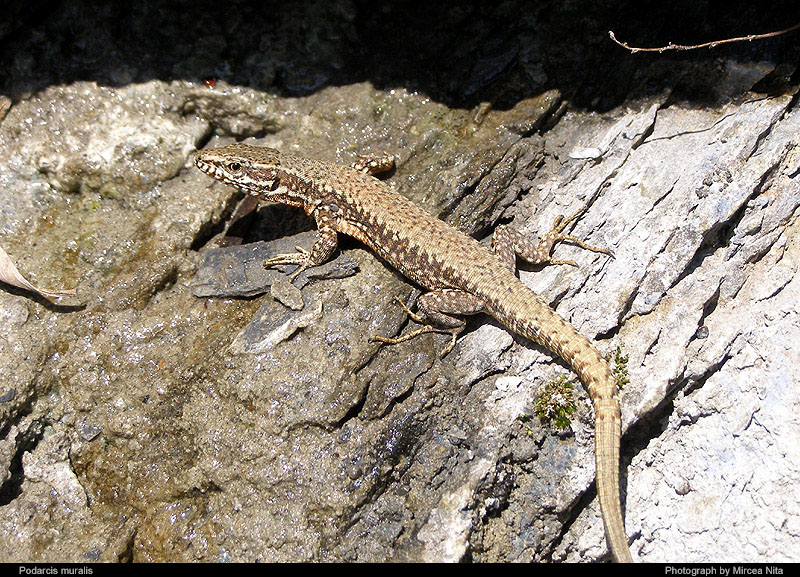
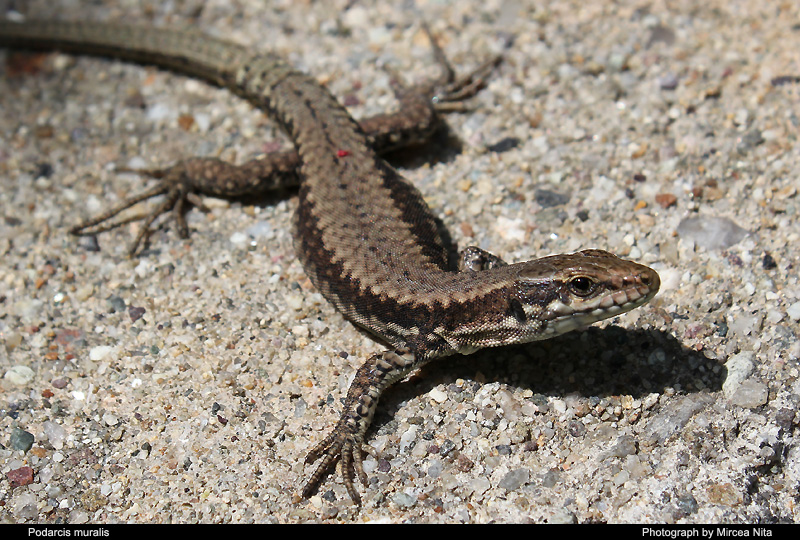
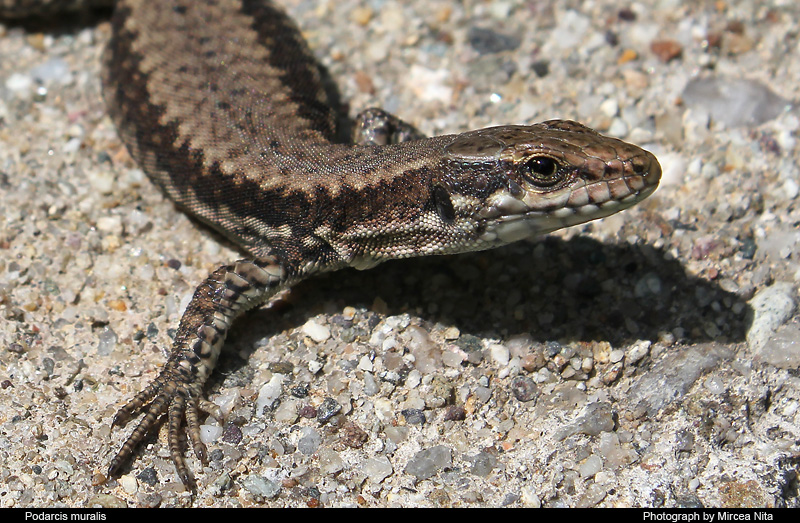
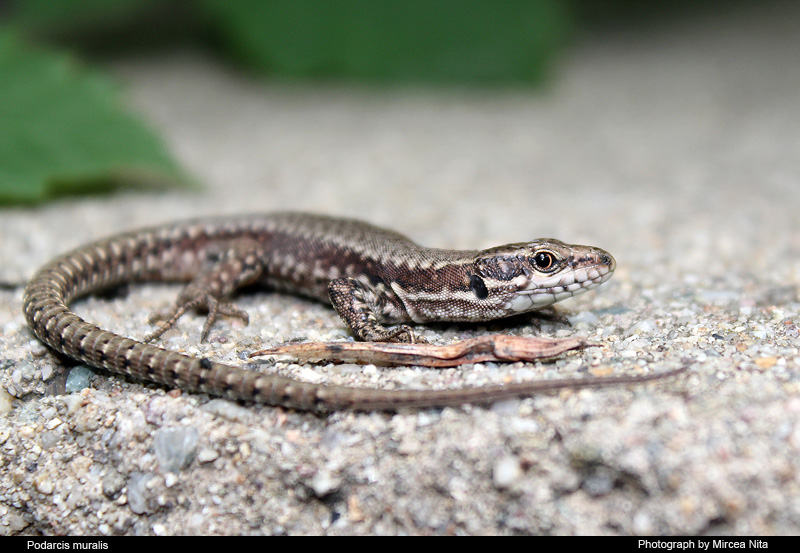
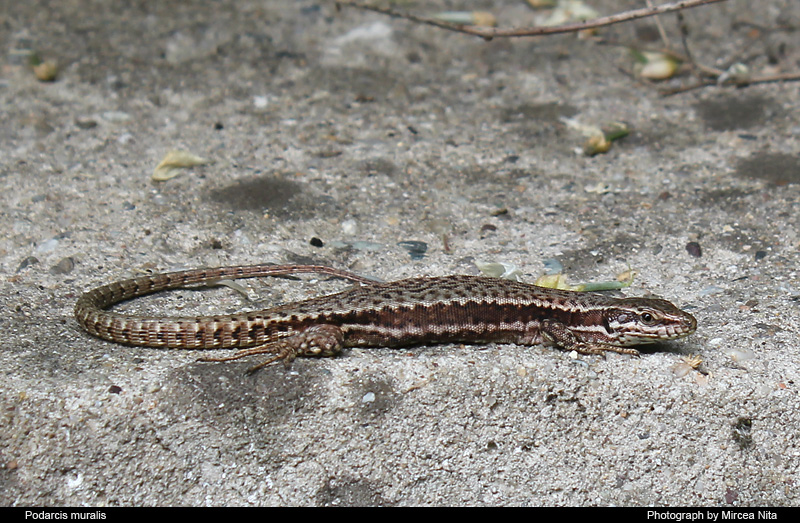
Podarcis muralis
Common wall lizard - Podarcis muralis: Laurenti, 1768
Description:
The wall lizard is a small reptile which reaches a total length of about 20cm; the snout-vent length is about 7cm, the tail being twice as long than the body. It is a rather flattened lizard, with a long narrow pointed head, long limbs and long toes, a smooth collar and small scales that are lightly keeled on the body.
This species has a huge amount of variation in the colouration. The general coloration over the upper parts is greyish or brownish occasionally with a green tinge present and with spots and blotches of all sorts. Females have darker flanks than males, pale dorso-lateral stripes and dark vertebral stripes or spots, males typically having a darker marked dorsal surface. The sides of males may have blue spots running down them that resemble a thick line. This is seen in some females, but the spots tend to be much smaller and lighter. The throat is usually a white/cream colour, with variable amounts of black pigment which can extend down to the belly (more often in males). Their bellies have large rectangular scales, the colour varying from whitish to reddish-orange many examples being yellow and others pink. The tail is brown or grey in colour, and may also have light bars on the sides.
Biology:
The wall lizard is an oviparous species and the females lay up to three clutches of two to six eggs per year. Mating starts shortly after the lizards come out of hibernation (usually mid March). About 4 to 6 weeks later the first clutch is laid. Larger females usually produce more clutches than small females. Eggs may be laid in sand, in the ground, under rocks or even under vegetation and can often be very difficult to find. The eggs incubate for about a month until the juvenile wall lizards hatch. Juvenile wall lizards have similar markings as adults (but much smaller). Compared with adult lizards, juveniles' heads appear to be proportionately larger. They reach sexual maturity at around 2 years.
At this species the period of hibernation is short, the winter sleep not being profound and wall lizards may be seen basking on the sunny days of winter, before the time has arrived for its usual spring appearance.
The wall lizards are very active and are easily seen in the open basking or hunting for food. They are very agile and quick at climbing and running and even jump from object to object when being chased. Like many other lizards, the wall lizard it autotomizes (drops) the tail when captured in order to escape predators.
Generally males are protective and will defend their territory of around 25 square metres and fights between rival males are not uncommon. However, in colonies with dense populations, males can exist without individual territories.
European Wall Lizards eat flying and ground insects such as flies, moths, butterflies, beetles, spiders, woodlice, crickets and grasshoppers. They are fast, active predators and can often be seen jumping off the ground to catch flying insects. These lizards also will eat fruit and berries. Juveniles eat the same prey as adults, but smaller specimens.
At this species females usually are slightly smaller in length and weight than males. Also the males have a larger head and a thick-set neck.
Within its natural environment, the wall lizard is prey to numerous predators like snakes, cats, weasels and birds.
The average life span for Podarcis muralis is up to 10 years (usually around 7 years).
Habitat:
The common wall lizard is a diurnal animal, and a sunshine lover which prefers rocky and scree areas, scrubland, deciduous and coniferous woodland, orchards, vineyards, fields, stone walls, and on buildings, being often found in human settlements including large cities and villages and railway lines. In the south of its range it tends to occur in humid or semi-humid habitats. It the more northern parts of its range it is mostly found in the driest areas.
Distribution:
This species is widely distributed in Europe. It ranges from northern Spain, northwards to northern France, southern Belgium, Luxembourg, west-central Germany, much of Austria, southwestern Czech Republic, central Slovakia and central Hungary, and eastwards to Romania, Bulgaria, most of the Balkans (excluding most of the Aegean islands) and northwestern Anatolia, Turkey. It occurs on Jersey in the Channel Islands (United Kingdom). It is largely absent from Northern Europe (it occurs as small patchy, isolated populations in the north of its range), southern Iberia (though there are fragmented, isolated populations in central Spain), and parts of southern Italy and its larger islands (Sardinia, Sicily, and Apulia). It has been introduced to the United States (and is spreading in Cincinnati, Ohio, Northern Kentucky) and Canada (Vancouver Island, British Columbia).
Range:
Albania; Austria; Belgium; Bosnia and Herzegovina; Bulgaria; Croatia; Czech Republic; France; Germany; Greece; Hungary; Italy; Liechtenstein; Luxembourg; Macedonia, the former Yugoslav Republic of; Montenegro; Romania; Serbia; Slovakia; Slovenia; Spain; Switzerland; Turkey; United Kingdom(England, introduced) , United States(introduced), Canada(introduced).
Scientific name: Podarcis muralis
Common name: common wall lizard, European wall lizard
Taxonomy:
A large number of subspecies have been attributed to Podarcis muralis in the past, although the numbers have recently been whittled down. The European Molecular Biology Laboratory (EMBL) reptile database recognises just ten: muralis, albanica, breviceps, brogniardi, brueggmanni, colosii, maculiventris, merremia, nigriventris and sammichelii.
IUCN Status: LC (Least Concern)
This species is listed as Least Concern in view of its wide distribution, presumed large population and broad range of habitats.
This species is listed on Appendix II of the Bern Convention, and on Annex IV of the European Union Habitats Directive. It is protected by national legislation in many countries (e.g. Switzerland), and occurs in a number of protected areas.
References:
Arnold, E. N., and J. A. Burton. 1978: A Field Guide to the Reptiles and Amphibians of Britain and Europe. Collins, London;
Boulenger, G.A. 1885. Catalogue of the lizards in the British Museum (Natural History). Vol. 2, Second edition. London;
Covaciu-Marcov S.-D.; Ghira, I.; Cicort-Lucaciu A.-St., Sas I.; Strugariu, A. & Bogdan H. V. 2006. Contributions to knowledge regarding the geographical distribution of the herpetofauna of Dobrudja, Romania. North-Western Journal of Zoology 2 (2): 88-125;
Deichsel, G. & Gist, D. H. (2001) "On the Origin of the Common Wall Lizards Podarcis muralis (Reptilia: Lacertidae) in Cincinnati, Ohio." Herpetological Review 32: 230-232;
Deichsel, G., and Schweiger, S. 2004. "Podarcis muralis (Common Wall Lizard). Canada: British Columbia". Herpetological Review 35: 289-290;
Fuhn, I. & S. Vancea, 1961: Fauna Republicii Române, 14. Reptilia (Testoase, Sopârle, Serpi). Bucuresti;
Gasc, J.-P., A. Cabela, J. Crnobrnja-Isailovic, D. Dolmen, K. Grossenbacher, P. Haffner, J. Lescure, H. Martens, J.P. Martinez-Rica, H. Maurin, M.E. Oliveira, T.S. Sofianidou, M. Veith & A. Zuiderwijk, 1997: Atlas of Amphibians and Reptiles in Europe. - Societas Europaea Herpetologica und Muséum National d'Historie Naturelle (IEGB/SPN), Paris;
IUCN 2012. IUCN Red List of Threatened Species. Version 2011.2;
Joger, U. & N. Stümpel, 2005: Handbuch der Reptilien und Amphibien Europas, Wiebelsheim;
Sos, T. 2008. Review of recent taxonomic and nomenclatural changes in European Amphibia and Reptilia related to Romanian herpetofauna. Herpetologica Romanica 2;
Szczerbak, N.N. 2003. Guide to the Reptiles of the Eastern Palearctic. Krieger, Malabar, FL.
|
|

